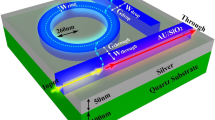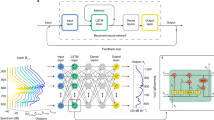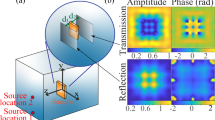Abstract
Resonance structures and features are ubiquitous in optical science. However, capturing their time dynamics in real-world scenarios suffers from long data acquisition time and low analysis accuracy due to slow convergence and limited time windows. Here we report a physics-informed recurrent neural network to forecast the time-domain response of optical resonances and infer corresponding resonance frequencies by acquiring a fraction of the sequence as input. The model is trained in a two-step multi-fidelity framework for high-accuracy forecast, using first a large amount of low-fidelity physical-model-generated synthetic data and then a small set of high-fidelity application-specific data. Through simulations and experiments, we demonstrate that the model is applicable to a wide range of resonances, including dielectric metasurfaces, graphene plasmonics and ultra-strongly coupled Landau polaritons, where our model captures small signal features and learns physical quantities. The demonstrated machine-learning algorithm can help to accelerate the exploration of physical phenomena and device design under resonance-enhanced light–matter interaction.
This is a preview of subscription content, access via your institution
Access options
Access Nature and 54 other Nature Portfolio journals
Get Nature+, our best-value online-access subscription
$29.99 / 30 days
cancel any time
Subscribe to this journal
Receive 12 digital issues and online access to articles
$99.00 per year
only $8.25 per issue
Buy this article
- Purchase on Springer Link
- Instant access to full article PDF
Prices may be subject to local taxes which are calculated during checkout




Similar content being viewed by others
Data availability
The source data of all figures in both main text and Supplementary Information are available at https://github.com/GaoUtahLab/Cascaded_GRU_Networks. The Zenodo version is available at ref. 45. Source data are provided with this paper.
Code availability
The code for the models in all three demonstrations of optical resonances and that support the plots within this paper and other findings of this study is available at https://github.com/GaoUtahLab/Cascaded_GRU_Networks. The Zenodo version is available at ref. 45.
References
Mudelsee, M. Trend analysis of climate time series: a review of methods. Earth Sci. Rev. 190, 310–322 (2019).
Topol, E. J. High-performance medicine: the convergence of human and artificial intelligence. Nat. Med. 25, 44–56 (2019).
Lim, B. & Zohren, S. Time-series forecasting with deep learning: a survey. Phil. Trans. R. Soc. A 379, 20200209 (2021).
Box, G. E., Jenkins, G. M., Reinsel, G. C. & Ljung, G. M. Time Series Analysis: Forecasting and Control (Wiley, 2015).
Goodfellow, I., Bengio, Y., Courville, A. & Bengio, Y. Deep Learning Vol. 1 (MIT Press, 2016).
Fu, R., Zhang, Z. & Li, L. Using LSTM and GRU neural network methods for traffic flow prediction. In 2016 31st Youth Academic Annual Conference of Chinese Association of Automation (YAC) 324–328 (IEEE, 2016).
Kong, W. et al. Short-term residential load forecasting based on lstm recurrent neural network. IEEE Trans. Smart Grid 10, 841–851 (2017).
Nelson, D. M., Pereira, A. C. & de Oliveira, R. A. Stock market’s price movement prediction with LSTM neural networks. In 2017 International Joint Conference on Neural Networks (IJCNN) 1419–1426 (IEEE, 2017).
Hyndman, R. J. A brief history of forecasting competitions. Int. J. Forecast. 36, 7–14 (2020).
Zhou, H. et al. Informer: beyond efficient transformer for long sequence time-series forecasting. Preprint at https://arxiv.org/abs/2012.07436 (2020).
Jiang, J., Chen, M. & Fan, J. A. Deep neural networks for the evaluation and design of photonic devices. Nat. Rev. Mater. 6, 679–700 (2021).
Ma, W. et al. Deep learning for the design of photonic structures. Nat. Photon. 15, 77–90 (2021).
Ras, G., Xie, N., van Gerven, M. & Doran, D. Explainable deep learning: a field guide for the uninitiated. J. Artif. Intell. Res. 73, 329–397 (2022).
Rangapuram, S. S. et al. Deep state space models for time series forecasting. In Proc. 32nd International Conference on Neural Information Processing Systems (NIPS 2018) 7796–7805 (Curran Associates Inc., 2018).
Salinas, D., Flunkert, V., Gasthaus, J. & Januschowski, T. Deepar: probabilistic forecasting with autoregressive recurrent networks. Int. J. Forecast. 36, 1181–1191 (2020).
Willard, J., Jia, X., Xu, S., Steinbach, M. & Kumar, V. Integrating scientific knowledge with machine learning for engineering and environmental systems. Preprint at https://arxiv.org/abs/2003.04919 (2020).
Karniadakis, G. E. et al. Physics-informed machine learning. Nat. Rev. Phys. 3, 422–440 (2021).
Pellizzari, T., Gardiner, S. A., Cirac, J. I. & Zoller, P. Decoherence, continuous observation, and quantum computing: a cavity qed model. Phys. Rev. Lett. 75, 3788 (1995).
Cirac, J. I., Zoller, P., Kimble, H. J. & Mabuchi, H. Quantum state transfer and entanglement distribution among distant nodes in a quantum network. Phys. Rev. Lett. 78, 3221 (1997).
Duan, L.-M., Lukin, M. D., Cirac, J. I. & Zoller, P. Long-distance quantum communication with atomic ensembles and linear optics. Nature 414, 413–418 (2001).
Mabuchi, H. & Doherty, A. Cavity quantum electrodynamics: coherence in context. Science 298, 1372–1377 (2002).
Englund, D. et al. Controlling cavity reflectivity with a single quantum dot. Nature 450, 857–861 (2007).
O’brien, J. L., Furusawa, A. & Vučković, J. Photonic quantum technologies. Nat. Photon. 3, 687–695 (2009).
Forn-Díaz, P., Lamata, L., Rico, E., Kono, J. & Solano, E. Ultrastrong coupling regimes of light–matter interaction. Rev. Mod. Phys. 91, 025005 (2019).
Siegel, P. H. Terahertz technology in biology and medicine. IEEE Trans. Microw. Theory Tech. 52, 2438–2447 (2004).
Tonouchi, M. Cutting-edge terahertz technology. Nat. Photon. 1, 97–105 (2007).
Mittleman, D. M. Twenty years of terahertz imaging. Opt. Express 26, 9417–9431 (2018).
Liu, H.-B., Zhong, H., Karpowicz, N., Chen, Y. & Zhang, X.-C. Terahertz spectroscopy and imaging for defense and security applications. Proc. IEEE 95, 1514–1527 (2007).
Lin, X. et al. All-optical machine learning using diffractive deep neural networks. Science 361, 1004–1008 (2018).
Li, Y., Chen, R., Sensale-Rodriguez, B., Gao, W. & Yu, C. Real-time multi-task diffractive deep neural networks via hardware-software co-design. Sci. Rep. 11, 11013 (2021).
Kleine-Ostmann, T. & Nagatsuma, T. A review on terahertz communications research. J. Infrared Millim. Terahertz Waves 32, 143–171 (2011).
Zhang, Q. et al. Collective non-perturbative coupling of 2D electrons with high-quality-factor terahertz cavity photons. Nat. Phys. 12, 1005–1011 (2016).
Li, X. et al. Vacuum Bloch–Siegert shift in Landau polaritons with ultra-high cooperativity. Nat. Photon. 12, 324–329 (2018).
Ulbricht, R., Hendry, E., Shan, J., Heinz, T. F. & Bonn, M. Carrier dynamics in semiconductors studied with time-resolved terahertz spectroscopy. Rev. Mod. Phys. 83, 543 (2011).
Jepsen, P. U., Cooke, D. G. & Koch, M. Terahertz spectroscopy and imaging-modern techniques and applications. Laser Photon. Rev. 5, 124–166 (2011).
Neu, J. & Schmuttenmaer, C. A. Tutorial: an introduction to terahertz time domain spectroscopy (THz-TDS). J. Appl. Phys. 124, 231101 (2018).
Nadell, C. C., Huang, B., Malof, J. M. & Padilla, W. J. Deep learning for accelerated all-dielectric metasurface design. Opt. Express 27, 27523–27535 (2019).
Ju, L. et al. Graphene plasmonics for tunable terahertz metamaterials. Nat. Nanotechnol. 6, 630–634 (2011).
Sutskever, I., Vinyals, O. & Le, Q. V. Sequence to sequence learning with neural networks. Adv. Neural Inform. Process. Syst. 2, 3104–3112 (2014).
Allen, L. & Eberly, J. H. Optical Resonance and Two-Level Atoms Vol. 28 (Courier Corporation, 1987).
Liu, Z., Zhu, D., Rodrigues, S. P., Lee, K.-T. & Cai, W. Generative model for the inverse design of metasurfaces. Nano Lett. 18, 6570–6576 (2018).
Jiang, J. et al. Free-form diffractive metagrating design based on generative adversarial networks. ACS Nano 13, 8872–8878 (2019).
Tang, Y. et al. Generative deep learning model for inverse design of integrated nanophotonic devices. Laser Photon. Rev. 14, 2000287 (2020).
Li, X. et al. Observation of Dicke cooperativity in magnetic interactions. Science 361, 794–797 (2018).
Tang, Y. et al. Code for paper ‘Physics-informed recurrent neural network for time dynamics in optical resonances’. Zenodo https://doi.org/10.5281/zenodo.6058054 (2022).
Acknowledgements
J.F. and W.G. thank the University of Utah start-up fund for support. X.L. acknowledges support from the Caltech Postdoctoral Prize Fellowship and the IQIM. C.Y. acknowledges support from grants NSF-2047176 and NSF-2008144.
Author information
Authors and Affiliations
Contributions
C.Y. and W.G. conceived the idea and designed the project. Y.T. performed the modeling and calculations with the help of J.F., J.M., M.Q., C.Y. and W.G. X.L. helped with the analysis of the Landau polariton data. Y.T. and W.G. wrote the manuscript. All authors discussed the manuscript and provided feedback.
Corresponding authors
Ethics declarations
Competing interests
The authors declare no competing interests.
Peer review
Peer review information
Nature Computational Science thanks Andrey Baydin, Bowen Zheng and the other, anonymous, reviewer(s) for their contribution to the peer review of this work. Primary Handling Editor: Kaitlin McCardle, in collaboration with the Nature Computational Science team.
Additional information
Publisher’s note Springer Nature remains neutral with regard to jurisdictional claims in published maps and institutional affiliations.
Supplementary information
Supplementary Information
Supplementary Figs. 1–10 and Tables 1–3.
Source data
Source Data Fig. 2
Numerical data for plots in Fig. 2.
Source Data Fig. 3
Numerical data for plots in Fig. 3.
Source Data Fig. 4
Numerical data for plots in Fig. 4.
Rights and permissions
About this article
Cite this article
Tang, Y., Fan, J., Li, X. et al. Physics-informed recurrent neural network for time dynamics in optical resonances. Nat Comput Sci 2, 169–178 (2022). https://doi.org/10.1038/s43588-022-00215-2
Received:
Accepted:
Published:
Issue Date:
DOI: https://doi.org/10.1038/s43588-022-00215-2



